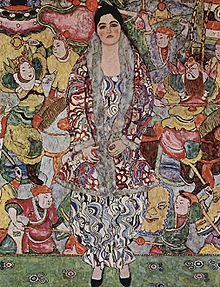Friederike Beer-Monti

Friederike Maria (Federica) Beer-Monti (born January 27, 1891 in Vienna as Friederike Maria Beer ; † July 12, 1980 in Kāneʻohe , Hawaii ) was an Austrian-American muse of well-known Austrian artists and gallery owners.
biography
Friederike Maria Beer was born in Vienna in 1891 as the daughter of the Jewish businessman Emil Beer (1861–1908) and his wife Isabella (1866–1959), b. Geissler, a niece of Salzburg Archbishop Franz Albert Eder , was born. After the early death of her father, her mother became the owner and landlady of the “Kaiserbar” at Krugerstraße 3 in Vienna, which in the 1920s became a meeting place for Viennese artistic Jeunesse dorée . Today the "Kruger's American Bar" is located there, partly with original furniture.
After finishing school, Friederike, called "Fritzi", took acting lessons and became a model for the clothes of the Wiener Werkstätte . Since childhood she was friends with the industrialist and painter Hans Böhler , he painted the seventeen-year-old as a standing female nude (1908). The picture was exhibited in the Vienna Secession . Both families were against a liaison, Friederike was sent to Belgium in 1911 to a boarding school run by the Ursulines, Hans Böhler to Beijing. After their return to Vienna in 1912, they resumed the relationship. Böhler had Josef Hoffmann set up an apartment for his girlfriend at Laimgrubengasse 4 . In 1913, together with Hans Böhler's brother Richard, both went on a one-year trip to Central and South America and New York. As Böhler's lover, Friederike Beer was associated with many artists from the Vienna Secession. In 1914 Egon Schiele painted a portrait of her. According to Beers himself, Böhler had promised her a special gift in 1915, a pearl necklace. Instead, she wanted a portrait of Gustav Klimt . At first he was reluctant, then he accepted the order. The portrait was completed in early 1916 and cost Böhler 20,000 crowns . A planned portrait of Oskar Kokoschka did not materialize because of the First World War . The couple separated at the end of 1916, but remained connected in a lifelong friendship. From 1918 on, Beer was entrusted with stamping and organizing Gustav Klimt's drawings that had been left behind in the Gustav Nebehay Gallery in Vienna.
In the mid-1920s, Friederike Beer married the Italian captain Emanuele Monti (* 1895) and lived with him on the island of Procida in the Gulf of Naples. It cannot be proven that, as has been mentioned many times, she ran the artist café “Zum Kater Hiddigeigi” on Capri . The marriage was divorced after four years, Friederike Monti-Beer returned to Vienna. In 1932 she met the American art history student Hugh Stix in the "Kaiserbar". In 1935 or 1936 she emigrated to the USA.
There Federica Beer-Monti, as she was now called, headed the “Artists' Gallery” founded by Stix in 1936, a non-profit organization similar to the Vienna Secession, which discovered and promoted American artists. (including Willem de Kooning , Louis Eilshemius , Louise Nevelson , Ad Reinhardt ). As a gallery owner, Beer-Monti helped Austrian artists to emigrate to the USA fleeing the Nazis, according to the painter Max Oppenheimer .
She managed the gallery until 1962, after Hans Böhler's death in 1961 she looked after his estate. In 1970 she moved to Hawaii , where she committed suicide on July 12, 1980.
literature
- Margret Greiner : “I want to become immortal!” Friederike Beer-Monti and her painters. Novel biography. Kremayr and Scheriau, Vienna 2019, ISBN 978-3-218-01185-3 .
Web links
Individual evidence
- ↑ a b Klaus Pumberger: What we haven't talked about. Aryanization, displacement, resistance, one house and the story of two families. Innsbruck / Vienna / Bozen 2015.
- ^ Butler Coleman: Tape-Recorded Interview with Mrs. Federica Beer-Monti. November 1, 1967, The Artists Gallery Archives of American Art, Smithonian Institute, Washington.
- ↑ Alessandra Comini : Egon Schiele's Portraits. University of California Press, Berkeley / Los Angeles / London 1974, pp. 128-132.
- ↑ Christian M. Nebehay: The golden armchairs of my father. Vienna 1983.
- ^ Marie-Agnes von Puttkamer: Max Oppenheimer, MOPP (1885–1954): Life and painterly work with a catalog raisonné of the paintings. Vienna 1999.
- ^ Martin Suppan: Hans Böhler. Life and works. Vienna 1990.
| personal data | |
|---|---|
| SURNAME | Beer-Monti, Friederike |
| ALTERNATIVE NAMES | Beer-Monti, Friederike Maria; Beer, Friederike Maria (maiden name); Beer, Fritzi (nickname); Beer-Monti, Federica |
| BRIEF DESCRIPTION | Austrian-American muse of Austrian artists and gallery owner |
| DATE OF BIRTH | January 27, 1891 |
| PLACE OF BIRTH | Vienna |
| DATE OF DEATH | July 12, 1980 |
| Place of death | Kāneʻohe , Hawaii |
